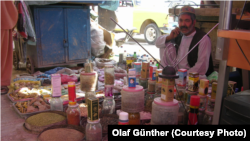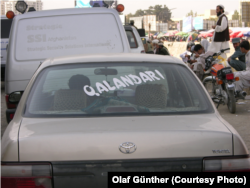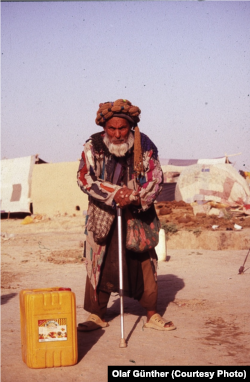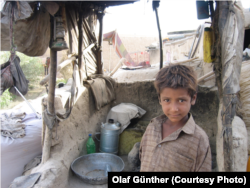What if academic analysis not only helped us to clarify the picture but also to distort it? In response to this question, the editors of the new book series called “edition tethys” propose a different approach: Personal encounters in the research environment are shown to be of the utmost relevance. This immediacy of contact can be preserved by avoiding analysis and opting instead for a deeply narrative reproduction of the author’s direct encounter with friends and strangers in foreign lands.
The people who contribute to the edited volume Encounters At The Hindu Kush (Begegnungen am Hindukusch in the German original), the second title in the series, do exactly that. They recount personal experiences in Afghanistan, Pakistan, and western China as established scholars, young researchers, or simply travelers. In one way or another, they are all connected to the Central Asian Seminar at Humboldt University Berlin. The same is true of the editors, Thomas Loy and Olaf Günther, who for 10 years published narrative accounts on their blog Tethys: Central Asia Everyday.
Some of the volume’s most poetic passages are written by Karl Wutt, who recalls his visits with the Pashai in eastern Afghanistan and his travels throughout Xinjiang, the westernmost province of China, with mujahedin traders eager to finance their war back home. He manages to convey impressions -- described by him as memory fractions – that are emotional responses to a picture or scene. Examples include long-distance bus rides under a starlit desert sky with the tobacco-smoking bus driver playing the same melancholic music on repeat.
Jürgen Wasim Frembgen evokes the atmosphere in Pakistani barber shops where the walls may be decorated with a curious combination of Arabic calligraphy, posters of Sufi masters, and photos of Indian actresses. When having his beard shaved in Lahore, he is served a milk tea while the barber takes a break to smoke some hashish. More than once when reading their accounts, I envied the authors for having collected impressions in places I will presumably never see myself.
Lutz Rzehak is particularly interested in the contrasting juxtaposition of people from different national backgrounds meeting. He describes an incident from Afghanistan a few years after the end of Taliban rule. One evening in an Iranian restaurant in Kabul’s wealthy Wazir Akbar Khan neighborhood, he observes three warlords sitting in the company of thinly veiled Thai prostitutes who attract other diners’ attention with their appearance, even more so when they start singing Happy Birthday in English.
The reader might also be surprised by the sometimes fundamentally different interpretations of both things and intangible phenomena of this world, nicely captured in the contribution by Olaf Günther. In Mazar-i-Sharif, he buys the patchwork coat of a mendicant for an exhibition in Germany and thus causes terror among the security personnel at the airport who refuse to check his luggage as long as the coat is lying on top. As friends of God, mendicants are believed to possess supernatural powers that can affect others in unforeseen ways. Fearing the mysterious forces within the coat, the security guards simply wave the author through the control.
Some contributors take a look into the past. Reinhard Schlagintweit, in an account of a journey to southwest Afghanistan, recreates the “golden period” of the 1950s and 1960s. Manfred Lorenz remembers a visit to Kabul in the 1970s with the aim of improving his Pashto textbook manuscript. He ends up communicating in that language with almost the entire staff at his hotel, who at the beginning seem to speak nothing but English and Dari.
Other authors focus on the changes society has undergone. When visiting Kabul a few years ago, Thomas Loy bought a book by the modern Afghan poet Qahar Asi about the last years under President Najibullah, the fall of Kabul to the mujahedin, and their subsequent rule, while the civil war continued. The conditions of those dark days become real in images of a spreading tendency of substance abuse along the river and the atrocities committed by the new rulers. Upon returning to one of his Pashai villages in the early 2000s, Karl Wutt notices that women are no longer singing or dancing at weddings and men are hard to recognize under their long beards.
A fascinating stylistic choice is made by Ingeborg Baldauf, who turns the ethnographic conventions around and instead characterizes family life in Takhar Province, in northeast Afghanistan, through the eyes of a multitude of family members. By constantly jumping from mind to mind, we seem to hear a babble of voices that enable us to gain an insight into people’s roles, their status, and mutual relations within the household. With its large cast, the text is complex, like a story by Tolstoy.
Urban geography is the realm of other authors. Ali Karimi writes about the Dasht-e-Barchi neighborhood in Kabul that is mainly populated by members of the Shi’ite Hazara community. He points out how Mazari Street is for those Hazaras who work as porters along that street not a means of getting from one end of the city to the other but an end in itself.
Thomas Ruttig attends to the neighborhood of Sherpur, where warlords with their crude taste in housing are responsible for having produced their own style called narcotecture that absolutely insists on the use of Doric pillars and eagle sculptures.
The Western influence in Afghanistan is an issue tackled by Hermann Kreutzmann. He asks how the presence of ISAF forces in Badakhshan Province allows for female emancipation. Some ideas of social progress going in this direction seep in from neighboring, formerly Soviet, Tajikistan.
The accounts where the narrators are pushed to their limits and sometimes beyond make for the most exciting reading. While spending a year in Islamabad, Andreas Dürr becomes friends with Afghan students who turn out to be Pashtun Islamists and later invite him to Afghanistan, where -- for reasons of convenience -- he takes on a local identity. Reading Dürr’s contribution, one realizes what working under difficult circumstances can mean.
Ayfer Durdu gives us an idea as to how the world looks from under a burqa. Being on the guest list of a Turkmen wedding north of Mazar-i-Sharif in what is effectively Taliban territory, she makes the decision to wear the garment. In the beginning, she struggles with walking on the pavement and establishing relations with another burqa-wearing passenger sitting next to her in the car. On one occasion, she is close to panic when almost losing her female company in the unfamiliar environment. But, eventually, she gladly dives into a sea of blue burqas at the wedding celebration.
The edited volume presented by Loy and Günther likewise invites the reader to dive into an ocean of sensory impressions of strange and mysterious beauty. Although not everyone will want to follow in the authors’ footsteps, the book feeds our desire to explore other worlds and makes us curious for the publications to come.
Jesko Schmoller is an anthropologist and senior researcher at the Centre for Comparative History and Political Studies at Perm State University. His most recent article (Problems of Post-Communism) is titled “Embodying Moral Superiority: The Master-Apprentice Relationship and National Cultural Heritage in Uzbekistan”. Currently, he works on the mobile and material aspects of Islam in the Urals.







